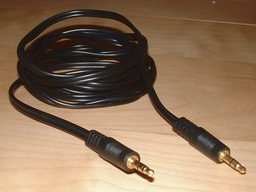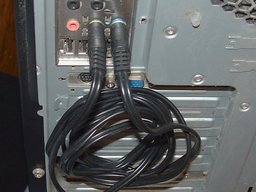FAQ:Recording
From Audacity Manual
> Forward To: FAQ:Opening and Saving Files
< Back To: FAQ:Installation and Plug-Ins
|< Index of Frequently Asked Questions
How can I record in stereo?
To record in stereo, open the Audacity Preferences. In the “Devices” panel in the Recording section, change the number of recording channels from 1 (Mono) to 2 (Stereo).
How do I record from vinyl records, cassette tapes, or minidiscs?
First, set Audacity to record in stereo.
Next, plug one end of a stereo cable into the “Line Out” or “Headphone” connector on your tape deck, minidisc player, or stereo system. Plug the other end into your computer’s “Line In” connector. If you do not have a cable that fits both of these connectors, you can find one at an electronics store.
Choose “Line In” as the input source on the Audacity toolbar, or in the Audio I/O tab of Preferences (Vista) or Apple Audio-MIDI Setup (OS X).
Next press the Record button. While Audacity is recording, start playing your tape or disc. When you have captured the audio you want to record press the Stop button.
Vinyl or shellac records can also be recorded into Audacity with a special type of turntable that connects to the USB port of your computer. These turntables need to be set up differently from those that connect to your line-in port. For instructions on setting up USB turntables, see USB_turntables on the Audacity Wiki.
There is also a detailed tutorial, Transferring_tapes_and_records_to_computer_or_CD, on the Wiki. This will guide you through the steps from recording your records, cassettes or minidiscs to exporting as an audio file and burning to CD.
Notes:
Do not plug stereo equipment into your computer’s “Microphone” port, which is designed for low-powered (“mic-level”) signals only. Use the “Line In” port instead.
Do not connect a turntable directly to your computer. The signal from a turntable is incompatible; it must be modified by passing it through a phono pre-amp or a receiver with a “phono” input.
See also:
Why doesn't the Mixer Toolbar input selector work properly, for example on Windows Vista?
The Input selector may be grayed-out, lacking the expected choices, or apparently not recording from the indicated source.
The cause varies by operating system and sound card driver. For example, on Windows Vista, you must use the "Recording Device" menu in the Devices panel of Preferences to select input sources. For more help, see the Mixer Toolbar Issues page on the Audacity Wiki.
Why can’t I hear what I’m recording?
Windows and Linux
To monitor your recording, open your computer's volume control panel. Turn up the playback volume and turn off the “mute” checkbox for your recording source (usually “microphone” or “line in”).
If this does not work open the Audacity preferences. In the “Recording” panel Playthrough section, turn on the “Software Playthrough” option.
Mac OS X
Open the Audacity preferences. In the “Recording” section turn on the “software playthrough” option.
Can I play a track while recording a new one on top of it?
This is called multi-track recording. It makes it possible to record harmonies with yourself, or add new instruments or vocals to an existing recording. To do this in Audacity, follow these instructions:
- Select the correct recording input that you are plugged into (probably microphone or line-in). On Windows or Linux, select the input in the dropdown menu in Audacity's Mixer Toolbar (on Windows Vista, use the "Recording Device" menu in the Devices panel of Preferences instead). On OS X, Mixer Toolbar may only show "Default Input". If so, select the source on the Audio Devices tab of Apple Audio MIDI Setup.
- Import or record the first track.
- Open the Recording panel of Audacity Preferences, and check the box labeled Overdub: Play other tracks while recording new one.
- Close the Preferences and press the Record button. If you are recording from a microphone, make sure you use headphones so that the microphone picks up only what you are recording.
See also:
Why isn’t my new track in sync with the previous ones?
When you make a multi-track recording, there is an unpredictable delay between playback and recording. Audacity tries to correct for this automatically, but this doesn't yet work on all computers.
If a new track is not synchronized with the others, you can zoom in and use the Time Shift tool to drag it to the correct location.
If you are doing a lot of overdubbing you may want to try our Latency Test to set a custom value for Audacity's latency correction.
Can Audacity record RealAudio or other streaming audio?
Windows and Linux
With most Windows and Linux audio devices, it is possible to record whatever sound the computer is currently playing, including internet radio streams.
In the drop-down menu on Audacity's mixer toolbar, choose “Wave Out” or “Stereo Mix” as the input source. (The exact name may be different, depending on your computer's sound drivers.) When you press the Record button, Audacity will capture whatever sound is playing on your computer's speakers.
On Windows Vista, the “stereo mix” option must be chosen in the Recording panel of Preferences. On Windows, if you don't have a “Wave Out” or “Stereo Mix” option, or if it won't record, go to the system Control Panel and try to enable this option there. For instructions see: Using the Control Panel on the Wiki.
If this doesn't work on your computer, you can instead use a cable to connect your computer's “Line Out” (speaker) port to its “Line In” port (known as a "loopback cable"), and use Audacity to record from Line In.
 A stereo mini-jack loopback cable |
 A loopback cable plugged into the back of a typical PC |
Mac OS X
Mac OS X users can capture streaming audio using a program like Soundflower (free, open source), Audio Hijackor Wiretap Pro.
Can I set Audacity to record at a certain time?
Yes! See Timer Record in the Transport menu.
You can also make Audacity stop recording after a certain time limit without using the Timer Record feature, by following these steps:
- Turn on “Play existing tracks while recording” in the “Audio I/O” section of the preferences.
- Choose “New Audio Track” from the Project menu.
- Zoom out if necessary, then click and drag to select the amount of time you want to record.
- Start recording. Audacity will stop recording automatically when it reaches the end of the selected area.
> Forward To: FAQ:Opening and Saving Files

